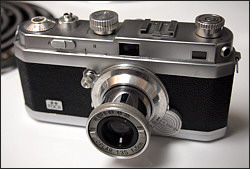Foca (Two Star)

|
|
|
| Style, film format | 35mm interchangeable lens rangefinder system |
|
|
|
| Lens, shutter | Coated collapsible 5cm f/3.5 Oplar, cloth focal-plane shutter |
|
|
|
| Photo quality | Good |
|
|
|
| Ergonomics | Generally very good |
|
|
|
This was the second in a series of cameras made by the French camera maker.
The Foca (Two Star) is so named because of the stars on its nameplate.
This model has some notable features, including an interchangeable collapsible standard lens, a wide-base rangefinder and flash-sync sockets for either electronic or bulb flash.
The Foca (Two Star) introduced a rangefinder to the series, and it's unified with the viewfinder. That is, there is just one eyepiece. The Foca's rangefinder is a bit different in that the secondary window is on the outside of the camera under the rewind knob. That allows for the viewfinder to be centered over the lens, meaning that there is no horizontal parallax error.
The body itself is very solid and well made. The back is removed to change the film. There is a takeup spool, which you don't want to lose.
There is definite heft to the camera, which feels nice in your hands. Advancing the film also tensions the shutter, and that's handled by turning the knob that doubles as the shutter-speed selector. You need to do this in a single motion, and you shouldn't let the knob accidentally rotate backward, because the sprocket wheel will rotate backward and then try to push the film back into the cassette. Nothing good can come from it.
You set the shutter speed by lifting the knob and turning it until a small hash mark lines up with the desired speed.
There are no slow speeds with this camera. The marked speeds are of the old style: 1000, 500, 250, 100, 50, 25 and B.
The small lever on the front is to set the camera to either A(dvance) or R(ewind). Rewinding is accomplished by twisting the knob again and again. There are two flash sync sockets on the camera's end -- one for bulb and the other for electronic.
You can focus either by using the lens' locking tab or the knurling on the front of the lens. To remove the lens, lock it at infinity, grab the front of the lens and twist counterclockwise. It's a screwmount. The focusing helical and rangefinder coupling is built into the body.
The shutter release is correctly sprung and requires the right amount of pressure and travel to release. The shutter speed dial spins during shutter travel, so you want to be careful not to let your finger touch it, or it will affect the shutter speed. This happened to me a couple of times.
In the photo below, you'll notice that the lens has non-standard aperture settings. Just select the one that's closest to what your meter indicates.

